Have you ever wondered how amazing it would be if you could prolong your Roman holiday for a year and explore all the historical, cultural, and natural riches Italy has to offer?
Thanks to Italy’s Digital Nomad Visa, you now can explore all 58 UNESCO World Heritage Sites located in Italy without having to sacrifice a day of your PTO or vacation days.
If you’ve been waiting for an opportunity to embrace the laid-back Italian lifestyle and enjoy the perks of being a digital nomad, we’ve got some amazing news for you.
The highly anticipated Italy digital nomad visa is finally out, and we’ve got all the details.
Read on to find out:
- The types of Italian visas available to digital nomads,
- What sets the actual digital nomad visa apart from the rest,
- Who can apply for the new digital nomad visa,
- A step-by-step guide to getting the Italy digital nomad visa,
- The pros and cons of being a digital nomad in Italy,
- The best Italian destinations for digital nomads, and
- Tips for working and living in Italy.
Let’s get into it!
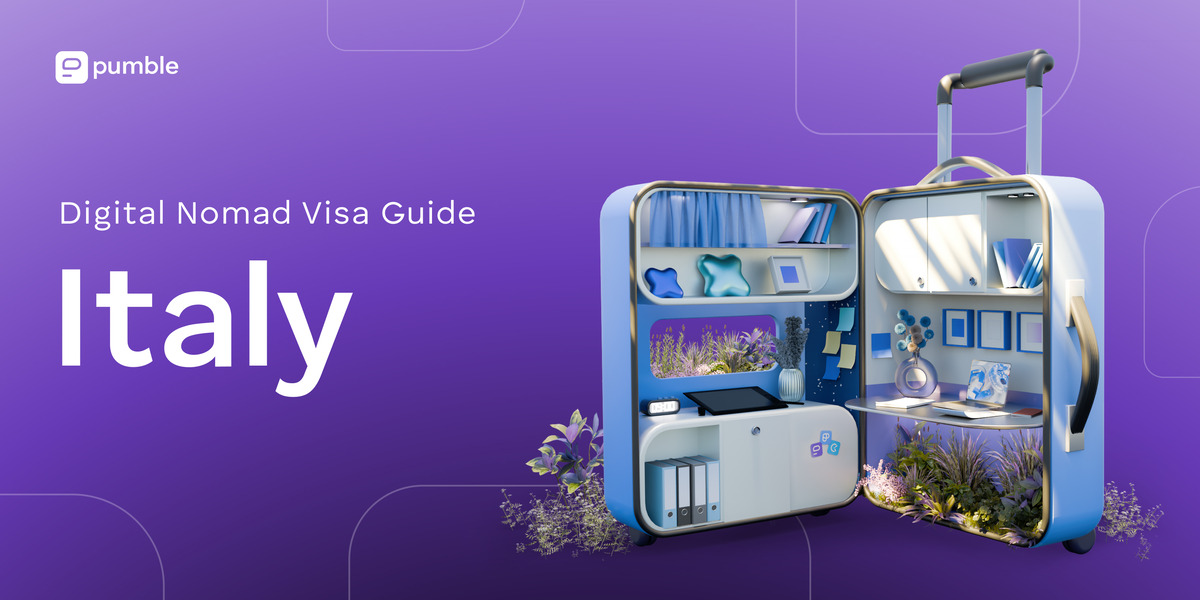
Quick facts for digital nomads in Italy
Before we go over the available programs for digital nomads in Italy, let’s first take a quick look at the most important digital nomad visa facts for Italy.
| Italy visa questions | Italy visa answers |
|---|---|
| Does Italy have a digital nomad visa? | Yes, the Digital Nomad/Remote Worker Visa |
| When was the digital nomad visa introduced in Italy? | April 4, 2024 |
| Who can apply for the Italy digital nomad visa? | – Non-EU citizens, – Self-employed professionals referred to as “digital nomads”, – Individuals employed by a company referred to by the regulation as “remote workers”, – Individuals who perform highly qualified work using telecommunications technology, and – Workers earning at least €25,500 (~$28,966.34) per year. |
| How much does an Italy digital nomad visa cost? | €116 (~$125.13) |
| Italy’s digital nomad visa length? | 1 year |
| Minimum stay requirement? | Not specified |
| Possible to extend the visa? | Yes, for another year |
| Minimum income requirements? | €25,500 (~$28,966.34) per year |
| Processing time for visa application? | 30 to 90 days |
| Can I apply with family members for a digital nomad visa? | Yes, but final approval is at the discretion of the Italian police headquarters. |
What to expect as a digital nomad in Italy?
From the beautiful scenery and comfortable climate to the rich history and vibrant culture — Italy has something for every type of digital nomad out there.
Here’s a quick look at what you can expect as a digital nomad in Italy, according to the available data.
| Italy digital nomad FAQ | Italy digital nomad answers |
|---|---|
| Average Internet speed: | – 80.19 Mbps — median download speed – 20.23 Mbps — median upload speed |
| Best coworking space (highest Google rating and highest number of voters): | Wire Coworking, Rome (4.9 stars from 116 voters) |
| Friendly to foreigners: | Yes — the locals are friendly and welcoming to tourists, digital nomads, and expats alike. |
| Most popular place for digital nomads in Italy: | Rome — impressive historical sites, colorful culture, and plenty of coworking spaces make the city a top spot for digital nomads. |
| Weather in Italy’s most popular place for digital nomads: | – Average annual temperature — 16.6°C (61.88°F); – Coldest month average temperature (January) — 8°C (46°F); – Hottest month average temperature (August) — 26°C (78°F); – 2470 sunny hours per year; – 79 rainy days per year. |
| Type of climate: | Mediterranean |
| Annual air quality average: | – US AQI — 57 (moderate quality, there may be a risk to some people sensitive to air pollution) – PM2.5 — 3x the WHO annual air quality guideline value (moderate quality) |
| Average cost of living: | – Family of 4: €2,985.5 (~$3,219.61) per month (without rent) – Single person: €854.8 (~$921.83) per month (without rent) |
| Average coworking space cost: | Median price €494 (~$532.78) per month |
| Crime index: | 46.97/100 (considered moderate) |
| Ranking of Italy’s healthcare system: | 28th place |
| Interesting fact for digital nomads: | Digital nomad community programs offer remote workers a chance to enjoy off-the-beaten-track locations in Italy. |
Does Italy have a digital nomad visa?
Yes. Italy’s digital nomad visa — the Digital Nomad/Remote Worker Visa — is officially available.
The visa was introduced in a Decree in January 2022, and in March 2022, it was signed into law.
Two years later, the Italian government issued the regulations and requirements for the entry and stay of digital nomads on the new visa.
As of April 4, 2024, digital nomads can now submit their applications for the Italy digital nomad visa.
Freelancers, remote full-time employees, and self-employed digital nomads can now stay in Italy long term and explore all its natural and cultural riches while working remotely.
What is the best visa for digital nomads in Italy?
The official digital nomad visa is the only Italian digital nomad visa. It’s safe to say that it’s the best one for digital nomads because it was designed to meet their specific needs.
It suits the most common work models and general lifestyle and preferences of digital nomads, with several benefits and administrative reliefs.
The Italian digital nomad visa:
- Defines the digital nomad category,
- Lists out the eligibility criteria for applying for a chance to live and work remotely in Italy long-term, and
- Details the simplified process for the application.
Let’s get all the details on the requirements, processes, and timing for applying for the Italian digital nomad visa.
Who is eligible to apply for Italy’s digital nomad visa?
The Italy digital nomad visa targets highly skilled non-EU professionals who work remotely using the Internet and other technological tools.
Highly skilled people are defined as having obtained:
- A college degree (minimum 3 years) from an accredited higher education institution,
- An accredited professional license, or
- Accredited superior professional experience.
The Italy digital nomad visa application is open for applicants who meet the following criteria:
- Citizens of countries that don’t belong to the European Union (EU citizens can already stay in Italy for up to 3 months without registration),
- Professionals who carry out highly qualified work activities (aka “highly-skilled” professionals),
- Digital nomads — defined by the regulations as freelancers,
- Remote workers — defined for the purposes of the visa as full-time employees working remotely for a company registered either in Italy or outside of Italy, who also must provide evidence of a current work contract,
- Applicants who have documented evidence of at least 6 months of work experience in the industry in which they plan to work remotely (applicants without a university degree must provide proof of up to 5 years of work experience),
- Applicants who have proof of an annual income of at least €25,500 (~$28,966.34),
- Professionals who can provide an affidavit signed by their employer that states they haven’t been convicted of immigration crimes over the last 5 years,
- Applicants who can provide proof of accommodation (rental agreement, booking, a certified copy of a property purchase contract, etc.), and
- Applicants who have health insurance that covers medical treatment and hospitalization during their entire stay in Italy. Insurance coverage must be at least €30,000 (~$32,354.96) or $50,000, if the insurance policy is issued in dollars.
What documents do you need to apply for Italy’s digital nomad visa?
After a long wait, detailed official requirements for applying for Italy’s digital nomad visa have been defined and announced.
One significant benefit of the Italian digital nomad visa is that applicants are exempted from having to obtain the “nulla osta” document — a work authorization for non-EU nationals issued by Italian immigration authorities.
Here’s the finalized official list of documents you’ll need to gather to be able to apply for the Italy digital nomad visa:
- Passport valid for at least 3 months after the expiration date of the visa.
- 2 recent passport-size photographs on a white background.
- A digital nomad visa application form obtained from the Italian Consular office for your location.
- Work contract with a company.
- Proof of sufficient financial means to support yourself during your stay in Italy (annual income of at least €25,500 (~$28,966.34). This income should stem from the work you will be performing while you reside in Italy and not from any passive forms of income, such as rents, stocks, Social Security, etc., as stated on the official Consolato Generale d’Italia a New York website.
- Proof of at least 6 months of work experience in the industry in which you plan to work remotely (applicants without a university degree have to provide evidence of 5 years of work experience). Tax returns, client invoices, and membership in professional or industrial associations can all be enough as evidence of your experience.
- Proof of accommodation — a notarized copy of a property purchase contract or a rental agreement.
- A criminal background affidavit signed by the employer stating that you haven’t been convicted of immigration crimes over the last 5 years.
- Medical insurance that covers medical treatment and hospitalization for the entire length of your stay in Italy (alternatively, you can sign up for the Italian National Health Service, which costs €2,000 (~$2,157.26) per year).
- Proof of the visa application fee payment — €116 (~$125.13) per person (depending on home country).
How do I get a digital nomad visa for Italy?
Now that you’ve checked your eligibility for applying for the Italy digital nomad visa, here is a step-by-step process for getting the visa:
- Set up an appointment with the relevant Italian Consulate responsible for the geographical area of your residency 2 to 4 months ahead of time,
- Complete the visa application form,
- Pay the visa application fee,
- Submit all of the mentioned documents (dated no earlier than 3 months) to the relevant Italian diplomatic or consular Representative in your country of origin or permanent residence,
- Wait 30 to 90 days for the visa processing and issuing.
Once your visa gets approved, you will have a 365-day validity period from the starting date.
Your next steps after receiving the Italy digital nomad visa include:
- Applying for a Permit to Stay (“Permesso di Soggiorno”) within 8 days of arriving in Italy,
- Applying for a tax identification number or “Codice Fiscale” issued by the Italian Revenue Agency (you can expect to be assigned a tax code directly by the police headquarters, however, in some cases, you might need to apply for one beforehand, for example, if you want to purchase property in Italy), and
- Applying for a VAT number at your local tax office in Italy (this is obligatory for anyone performing “business or agricultural activity or an artistic or professional activity on a regular basis” and anyone earning over €65,000 (~$71,024.20) as a self-employed person).
What other types of visas suitable for digital nomads does Italy offer?
In addition to the official digital nomad visa, there are other visa options people who want to live and work remotely in Italy can look into.
There are essentially 3 alternative visa options you can explore as a digital nomad in Italy:
- Tourist (short-term) visa,
- Self-employment visa, and
- Passive income (Elective residence) visa.
Let’s take a closer look at each of these visa options and what they entail.
Type #1: Tourist visa
The Italian tourist visa is a great option for digital nomads looking for a short-term stay without any legal obligations.
You can stay up to 90 days within a total period of 180 days in Italy on a tourist visa, and you don’t need to register with the local institutions or apply for a residence permit.
To enter and stay in Italy on a Tourist visa, you only need to fulfill 2 requirements:
- A passport valid for at least 3 months longer than your intended stay and
- Documents justifying the reasons and duration of your stay in Italy.
A tourist visa is a perfect option for digital nomads who want to stay in Italy for short periods.
If, however, you’re looking for long-term residence, you might want to explore one of the next 2 options.
Type #2: Self-employment visa
The self-employment visa is a great alternative for people looking to live and work in Italy — either by freelancing or starting a business.
This visa is regulated by the annual entry quotas established by the law known as the “Decreto Flussi” (Flow Decree), which allows a set number of work permits to be issued to applicants whose work activities fall under the criteria set for the self-employment visa.
General documentation for the self-employment visa
The self-employed visa grants the right to live and work in Italy for up to 2 years, and it comes with several requirements.
The specific requirements and documentation vary depending on whether you plan to work as a freelancer or start a business in Italy.
In both cases, you’ll need a general list of documents, which includes:
- Visa application form,
- Recent passport-size photograph,
- Passport valid for at least 3 months longer than the length of the requested visa,
- Proof of accommodation for the entire stay,
- Proof that you have paid the application fees (around €116 (~$125.13)), and
- Proof that you had a yearly income of at least €8,500 (~$9,169.07) in the previous year.
It’s important to note that, for some professions, there’s a higher yearly income requirement than for others.
Boost your communication with Pumble
Specific documentation for the self-employment visa
If you’re looking to apply for the self-employment freelancer visa or the self-employment business owner visa, you’ll also need:
- A “Nulla osta” (no impediment) work certificate from the relevant Questura (police station),
- A Certificate of abstract recognition of the resources necessary for the business, trade, or craft activity you plan to undertake, issued by the relevant Chamber of Commerce (not less than the minimum annual income — €14,000 (~$15,099.30), and
- Proof that you have sufficient financial funds in Italy to guarantee the resources for the Certificate.
You also have a third option at your disposal — the self-employment start-up visa. This is a self-employment visa option applicable to people looking to open an innovative start-up business in Italy.
To apply for this visa, you’ll have to get a specifically designed “nulla osta” authorization from the Italy Startup Visa Technical Committee at the Ministry of Economic Development.
Type #3: Passive income visa
The Passive income (Elective residence) visa is primarily intended for retirees who want to stay in Italy long-term.
However, as the requirements don’t necessarily state that you have to be retired to obtain this visa, you can look into this option as an alternative digital nomad visa for Italy.
Essentially, you’ll only have to prove that you have an income larger than €31,000 (~$33,434.18) per year from sources other than paid employment wages or work-related money and savings.
For example, a passive income can include anything from the rent you receive from a property you own outside of Italy to a pension from a government or other institution.
To apply for the Italian passive income visa you’ll need:
- Visa application form,
- Recent passport-size photograph,
- Passport valid for at least 3 months longer than the length of the requested visa,
- Proof of accommodation for the entire stay (a signed ownership or rental contract), and
- Proof of extensive financial resources under the applicant’s name. The resources need to be stable and regular, and they have to be from sources other than paid employment.
While all these documents and requirements are listed on the official website of the Italian Ministry of Foreign Affairs and International Cooperation, it’s best to contact the visa office of the nearest Italian Embassy or consult your local Italian diplomatic mission to check the detailed requirements and documents.
How long does it take to get a digital nomad visa for Italy?
You can expect the visa issuing process for the Italy digital nomad visa to take anywhere from 30 to 90 days if the paperwork you filed is in order. In some cases, the visa can be issued on the day of application, however, the Consulate is legally bound to respond within a maximum of 90 days.
Can I bring my spouse or children to Italy?
The short answer is yes, your spouse and children can come to Italy. However, the trick is that the application process must be initiated by you, after you arrive in Italy.
Once you are in Italy as an approved digital nomad or remote worker, you can sponsor your spouse or minor children for a family visa.
You need to be legally married to your spouse (not separated or separating), and your child (or children) must be under 18. You can also sponsor your stepchildren, provided that their other parent also consents to the issuance of the visa.
Unfortunately, you can’t sponsor children over 18 or your parents to join you in Italy, even if they are dependent on you.
Furthermore, the entire process has to begin in Italy at the Questura where you applied for the residency permit. They can also give you the specific details regarding sponsoring your close family members for an Italian visa.
Does the Italian digital nomad visa lead to citizenship?
Although the Italian digital nomad visa grants residency, it does not lead to citizenship, per se.
That being said, you can technically get permanent Italian citizenship if you start on a digital nomad visa. If you manage to extend your temporary residence permit for digital nomads in Italy for 5 consecutive years, you can apply for a long-term resident EU card. After being a long-term resident EU card holder for another 5 years, you can apply for permanent Italian citizenship.
To get to this point, your first step would be to renew your temporary residence permit every year for 5 years by meeting the same initial requirements and paying the necessary fees each time.
The country also offers other options such as The Investor Visa scheme that can lead to permanent citizenship.
Do digital nomads pay tax in Italy?
Digital nomads will have to pay tax in Italy, according to a previously mentioned amendment to the Law converting Decree-Law n. 4/2022 (Sostegni ter).
However, there are 2 favorable tax regimes offered to newcomers, and it’s safe to assume that digital nomads will be eligible for these reliefs:
- The “Regime Forfetario” — which allows self-employed individuals earning a gross yearly income of up to €85,000 (~$91,687.38) to pay a 5% flat tax for the first 5 years on a percentage of gross billings, and
- The “Impatriates Regime” — which allows a 50% tax exemption on earned income subject to tax to self-employed and unemployed individuals (provided the income is up to €600,000 (~$647,253.00) per year).
Moreover, US and dual US/Italian citizens who work in Italy can choose to pay taxes for social security through the US Social Security system per the Totalization agreement between the US and Italy.
To ensure a smooth tax registration process, it’s best to take a couple of precautionary steps before arriving in Italy:
- Check your eligibility and the conditions for the tax relief,
- Plan the timing of tax payments in advance, and
- Seek professional advice on the timing of the move.
How to pay tax on a digital nomad visa in Italy?
To pay tax in Italy, you’ll need a unified tax form F24.
However, before you’re able to pay taxes in Italy, you need to register for (in this case) self-employment tax in Italy.
To do so, you must first get a tax identification number or “codice fiscale” issued by the Italian Revenue Agency. You can do that by taking your passport and residence card to your local immigration desk or police headquarters.
In most cases, you can expect to be assigned a tax code directly by the police headquarters, however, it’s advisable to apply for one yourself ahead of time, for example, when you want to purchase property in Italy.
If you’re a non-EU citizen, you’ll also need to define your business structure before registering for self-employment tax.
Can I live in Italy without a digital nomad visa while working remotely?
Yes, there are ways you can live in Italy without a digital nomad visa while working remotely, but the conditions vary depending on your country of origin and permanent residence.
If you are an EU citizen, you can live and work remotely in Italy without any visa for up to 90 days.
After that, you are required to register with the local “Anagrafe” (Register Office).
In addition to EU/EEA citizens, nationals of the following countries looking to stay in Italy for up to 90 days don’t have to apply for a work visa:
- Australia,
- Israel,
- Japan,
- Canada,
- New Zealand,
- The Republic of South Korea, and
- The USA.
However, if they wish to stay in Italy for more than 90 days, they need to apply for a residence permit.
Citizens of any other country must apply for a digital nomad visa or an alternative (work) visa type mentioned above.
Working remotely? Communicate via Pumble
Are you eligible if you are a United States citizen?
Yes, as a US citizen, you are eligible for the Italian digital nomad visa. You just need to provide all of the required documentation and meet the mentioned requirements.
Are you eligible if you are a US Green Card holder?
Currently, there is no information about United States citizens with a Green Card who want to apply for Italy’s digital nomad visa.
It’s safe to assume that simply meeting all the necessary requirements is enough for the authorities to grant you a digital nomad visa.
However, we highly advise you to consult your nearest embassy or consulate for more information on obtaining Italy’s digital nomad visa to get detailed information for your specific situation.
Are you eligible if you reside in any other country?
There are no specific restrictions for any country regarding obtaining Italy’s digital nomad visa. The only thing that can differ between countries is whether you need a visa to enter Italy or not.
All requirements for individuals should be the same for everyone. However, if you have reasons to doubt this, we advise you to check with your nearest embassy or consulate before you start collecting the required documents and planning your trip.
What are the costs you need to consider as a digital nomad in Italy?
Now that we’ve figured out all the different ways you can stay in Italy as a digital nomad, it’s time to crunch the numbers and see if it’s realistically feasible to do so.
Considering all it has to offer, Italy is not an excessively expensive country. If you have a decent income and perhaps some extra cash for a few additional trips around the country, you’ll definitely do more than just get by in Italy as a digital nomad.
On the graph below, you can see how the average Italian spends their money each month.
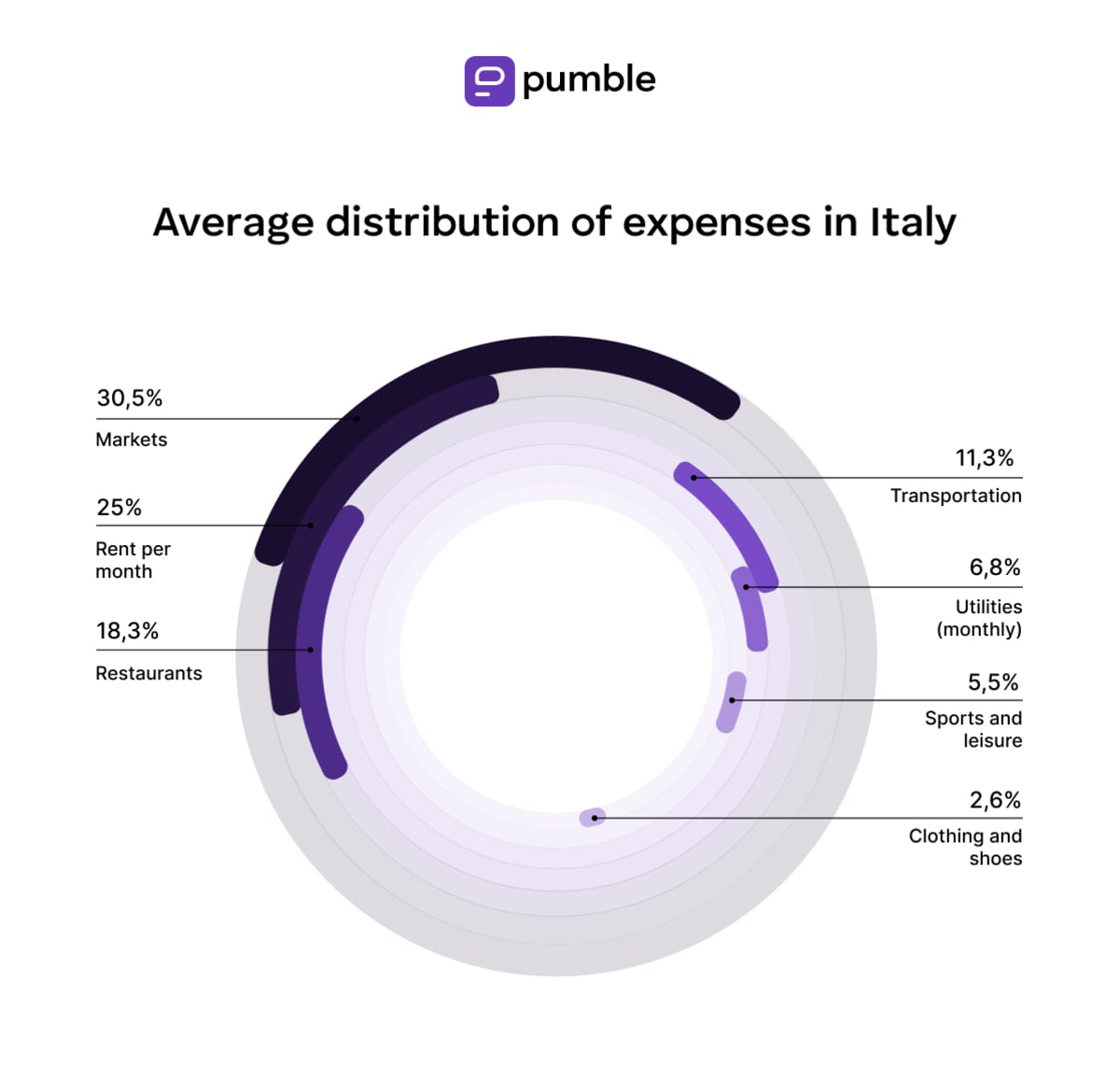
Now let’s break down all the major expenses to see how big of a budget you’ll need as a digital nomad in Italy.
Expense #1: Rent (or accommodation)
First things first, you’ll need to consider probably the highest expense you’ll have as a digital nomad in Italy — accommodation.
The monthly rent for a 1-bedroom apartment in the larger city centers is around €780 (~$841.43). For a 3-bedroom apartment in these areas, you’ll need around €1,386.52 (~$1,495.72).
Naturally, the rent prices are significantly lower in locations outside of the city center, where you can get a 1-bedroom apartment for €576.80 (~$622.23) per month and a 3-bedroom for around €959.81 (~$1,035.40) per month.
Let’s take a closer look at the average rent prices for 1-bedroom apartments in the most popular cities for digital nomads in Italy.
| City in Italy | Average cost of rent for a 1-bedroom apartment (per month) |
|---|---|
| Rome | 1,000–€1,600 (~$1,078.79–$1,725.78) |
| Milan | €1,000–€2,000 (~$1,078.79–$2,157.23) |
| Florence | €800–€1400 (~$862.89–$1,509.94) |
| Palermo | €450–€750 (~$485.34–$808.89) |
| Naples | €650–€1,500 (~$701.04–$1,617.79) |
Expense #2: Utilities
For basic utilities in Italy, you’ll have to pay between €148.8 and €272.25 (~$160.45–$293.57) per month — depending on whether you’re living alone or with your family members.
This includes:
- Electricity,
- Heating and AC,
- Water, and
- Garbage.
Sometimes, utilities will be included in your monthly rent price. So, if you’re renting a place in Italy, be sure to check whether that’s the case.
For cable or ADSL Internet you’ll pay around €28 (~$30.19) per month. A prepaid SIM card costs around €10 (~$10.78), while you’ll need to spend around €25 (~$26.96) for an unlimited monthly plan.
Expense #3: Transportation
Like most European countries, Italy is perfectly pedestrian-friendly. In addition to being considered rather safe, Italy is also one of the countries with the most amazing cultural, historical, and natural attractions, so walking is most certainly the best way to get around and explore.
Cycling is another healthy and convenient option, as Italy is also a generally bike-friendly country.
For traveling between cities and towns, we suggest you take advantage of the famously extensive inner-city and regional train network.
The metro train system is also a super effective and cheap way to get around bigger cities such as Rome, Milan, and Naples.
We spoke to Saema Nasir, a B2B PR Consultant and CEO, who spent a month in Rome as a digital nomad in 2023.
She chimed in on the topic of public transport in Italy (more specifically, Rome):

“Rome has excellent public transport on top of being very walkable. As digital nomads typically a) work online and b) don’t have cars — the dual combination of a good net with a highly accessible city for walking and short, inexpensive taxi rides make it an excellent city for digital nomads.”
That being said, let’s not forget that most Italian cities are not very car- or bus-friendly, mostly due to the traffic and narrow streets, and due to the somewhat more aggressive local driving culture. A great and faster alternative would be to rent a motorcycle or a Vespa, especially during summer days.
| City in Italy | Monthly public transport ticket price |
|---|---|
| Rome | €35 (~$37.74) |
| Milan | €39 (~$42.06) |
| Florence | €35 (~$37.74) |
| Palermo | €31.5 (~$33.96) |
| Naples | €35 (~$37.74) |
Expense #4: Groceries
The prices of groceries in Italy vary between different cities and different types of stores.
If you stay in Rome or Milan, for example, you can expect higher prices in supermarkets and markets than you would encounter in smaller cities.
Since Italy is famous for delicious local food, you might want to explore smaller markets and local shops for fresh produce and a great quality-price ratio.
If you want a rough average estimate of how much you’ll spend on groceries in Italy, here’s a list of average prices of some commonly bought groceries:
| Groceries | Price |
|---|---|
| Milk 1l (33.8 fl oz) | €1.45 (~$1.56) |
| Bread 500 g (1.1 pounds) | €1.98 (~$2.13) |
| Water 1.5l (50.7 fl oz) | €0.43 (~$0.46) |
| Local cheese 1 kg (2.2 pounds) | €13.36 (~$14.40) |
| Chicken filets 1 kg (2.2 pounds) | €10.55 (~$11.37) |
| Red meat 1 kg (2.2 pounds) | €16.87 (~$18.19) |
| Tomatoes 1 kg (2.2 pounds) | €2.79 (~$3.01) |
| Apples 1kg (2.2 pounds) | €2.1 (~$2.26) |
Expense #5: Restaurants and cafes
Delicious cuisine is probably one of the top 3 first things associated with Italy — and for good reason. The country really lives up to its reputation regarding amazing food — from thousands of Michelin-star restaurants to the world’s best pizza place and traditionally great coffee and wine culture, Italy really has it all.
And if you’re wondering how much you’ll have to pay to enjoy all of this delicious food in Italy, you’ll be happy to know that it’s quite affordable, considering the quality.
For example, you can get a 3-course meal for two people at an average or mid-range restaurant for around €48–€100 (~$51.74–$107.80).
Prices in cafes and bars go from €1.63 (~$1.76) for a cappuccino and €5 (~$5.39) for a bottle of beer, while a bottle of Coke or Pepsi is around €2.46 (~$2.65).
Expense #6: Internet
Italy has great internet coverage pretty much anywhere in the country. In fact, it has fixed broadband and NGA coverage levels above the EU average.
As mentioned above, your monthly internet expenses will be around €28 (~$30.20).
The median download speed of fixed broadband Internet in Italy is currently 80.19 Mbps, while the median upload speed is 20.23 Mbps.
As you may recall, our expert, Nasir, sang praises to Italy’s internet connectivity. She mentioned the reliability is something every digital nomad will appreciate:

“I never once had a problem with poor internet connectivity in Rome, and I think having the peace of mind of always being connected was a significant benefit of being a digital nomad there.”
Expense #7: Coworking spaces
If you like to keep your work area separate from your living space, you’ll need to add the costs of coworking space to your monthly list of expenses.
Prices of coworking spaces in Italy vary depending on the city and area you live in.
Milan, for example, is one of the cities with the most expensive monthly hot desk prices in Europe. For a desk at one of the coworking spaces in this city, the median is around €494 (~$532.75) per month (though there are many affordable options to be found in this city).
Rome is similarly pricey, with median monthly prices of €424 (~$457.36). However, in Florence, the median is noticeably lower — around €304 (~$327.92).
What are the benefits of being a digital nomad in Italy?
As one of the most beautiful countries in the world, Italy has always been a top vacation destination for people of all ages and interests.
While your favorite vacation spot doesn’t always translate into a perfect work location, you’ll notice that many of the benefits we list below also apply to digital nomad life in Italy.
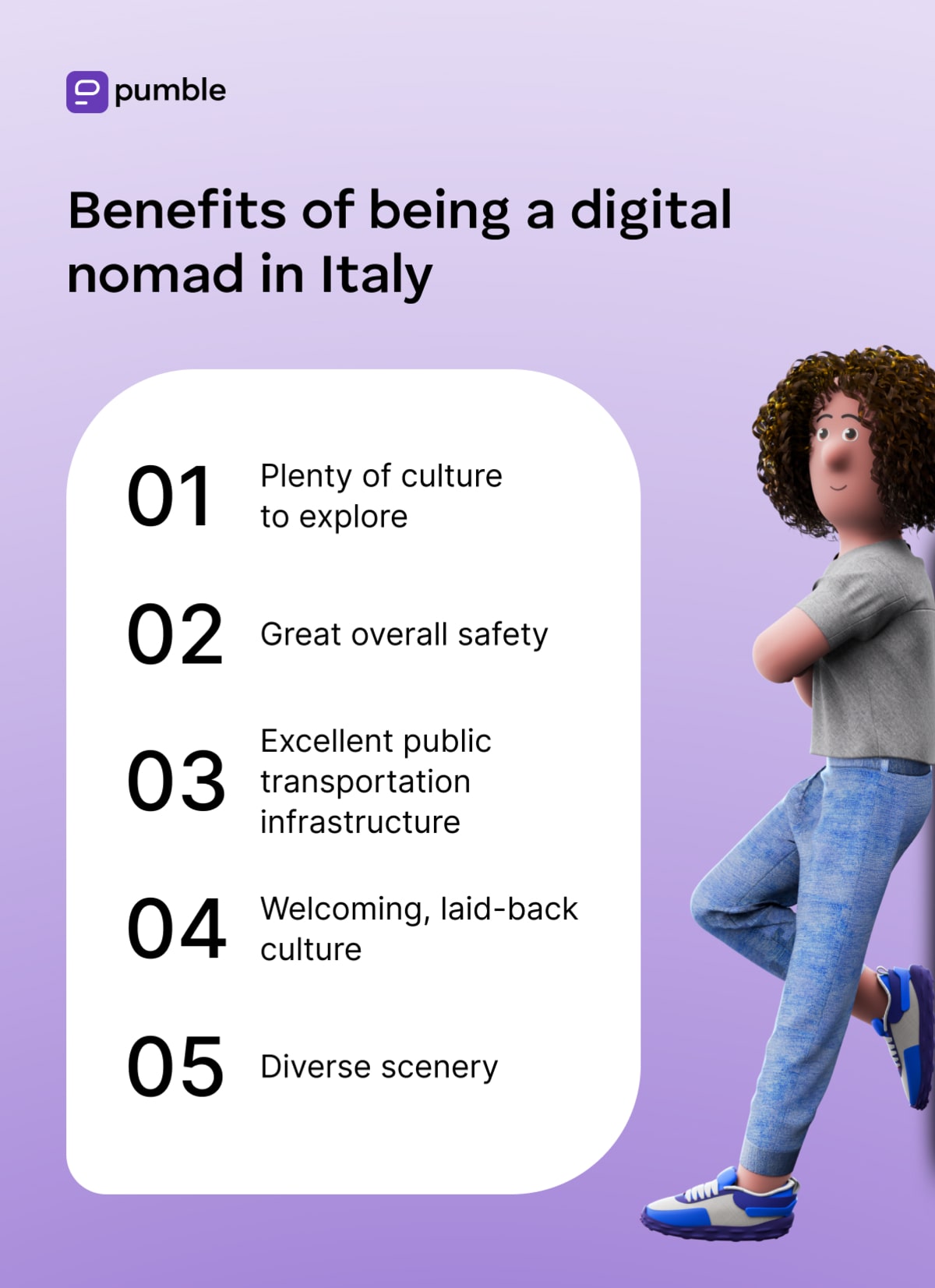
Here are all the reasons Italy is a great place for digital nomads.
Benefit #1: Plenty of culture to explore
One of the biggest reasons digital nomads decide to spend their time in Italy is to experience its mesmerizing culture.
Italy is home to the largest number of UNESCO World Heritage Sites in the world. Considered a cultural superpower, its influence spans centuries and across all arts.
Pretty much anywhere you step in Italy, you will have a chance to encounter a cultural or historic landmark, especially in the most popular cities among digital nomads.
You can experience the breathtaking architecture of the Colosseum, Duomo di Milano, or Fontana di Trevi.
More of an indoor type of person? Galleria Borghese, Museo Egizio, or Palazzo Conte Federico are waiting for you!
Any way you look at it, you will surely have tons of fantastic experiences to write home about when visiting Italy!
Benefit #2: Great overall safety
Crime levels in Italy are generally low which is why it is considered a safe country to live in. What’s more, when it comes to individual rights and liberties, Italy can be classified as a relatively progressive country.
The locals are generally very tourist-friendly and most digital nomads experience a warm welcome in all of Italy’s cities.
Apart from petty crimes such as pickpocketing (especially in tourist-crowded places), you won’t need to worry about much else. For the most part, you can relax and enjoy your stay.
When asked about the benefits of being a digital nomad in Italy, and Rome in particular, our expert, Nasir, highlights feeling perfectly safe while staying in the city:

“I never once felt unsafe as a solo female traveler in Rome when I was there for a month in 2023. Since I last visited in 2015, the city has become infinitely safer, in my opinion. It’s not uncommon to see police officers and even army members patrolling and stationed near major tourist sites such as the Colosseum or the Pantheon, keeping an eye out for pickpockets. While to some this may be overkill, I found it heightened my sense of safety.”
Nasir added that it’s not just police presence that makes Italy so safe:

“I felt extremely safe even later in the evening, after sunset in non-touristy areas like Trastevere or Prati, where there would be much less police presence. In the late evening in Trastevere particularly, lots of locals, travelers, and Romans would be out and about enjoying the delicious authentic Roman dining and street performers without any worry about safety. These crowds also fueled a sense of safety for me as a solo traveler.”
Benefit #3: Excellent public transport infrastructure
The country is widely known for its amazing railway system. It is reliable and well-connected — both in city areas and between major cities.
Tickets booked in advance allow for discounts on both regional trains (suitable for the more budget-conscious) as well as on the high-speed trains (for those who value speed over price).
Naples, Rome, and Milan have metro systems, while smaller cities have extensive networks of buses and trams.
We highly recommend checking out apps of bus companies in your city of choice, since many offer discounted prices and share live updates on their services. Buying tickets online will generally grant you good discount options, so keep that in mind before purchasing your tickets at a kiosk.
We also recommend downloading transportation apps like Moovit or ATAC’s official app for Rome (when in Rome!). Both of these apps will provide you with real-time updates on transportation, routes, and timetables.
Benefit #4: Welcoming, laid-back culture
Italy is known for its traditionally relaxed, easy-going attitude towards life in general.
What is different from other Western countries is that, in Italy, things tend to move at a somewhat slower pace.
One of the things digital nomads find hard to get used to is the midday break — also called the “Pausa”.
The “pausa” lasts for a couple of hours, and many places shut down during it. If you are not mindful of this, it can be particularly challenging for you to finish your errands.
However, don’t worry — you’ll get used to it. Many digital nomads and naturalized Italian citizens often report appreciating this “slowing down” compared to their prior lifestyles.
Benefit #5: Diverse scenery
From scenic coasts and valleys to gorgeous mountain landscapes and volcanoes — Italy has it all.
If you’re looking for natural wonders, look no further than Mount Etna or Zingaro Nature Reserve.
Pristine beaches in Italy such as Cala Mariolu on the island of Sardinia or Spiaggia dei Conigli are awesome choices for a summer travel experience.
If you’re more of a winter type of person and a skier, then you will probably love Champoluc or Gressoney.
However you look at it, Italy offers countless options the whole year round, so you won’t miss out, regardless of the season you choose to visit it.
What are the drawbacks of being a digital nomad in Italy?
While the pros of being a digital nomad in Italy highly outweigh the cons, there are still a few drawbacks to consider before you start packing for your Italian digital nomad adventure.
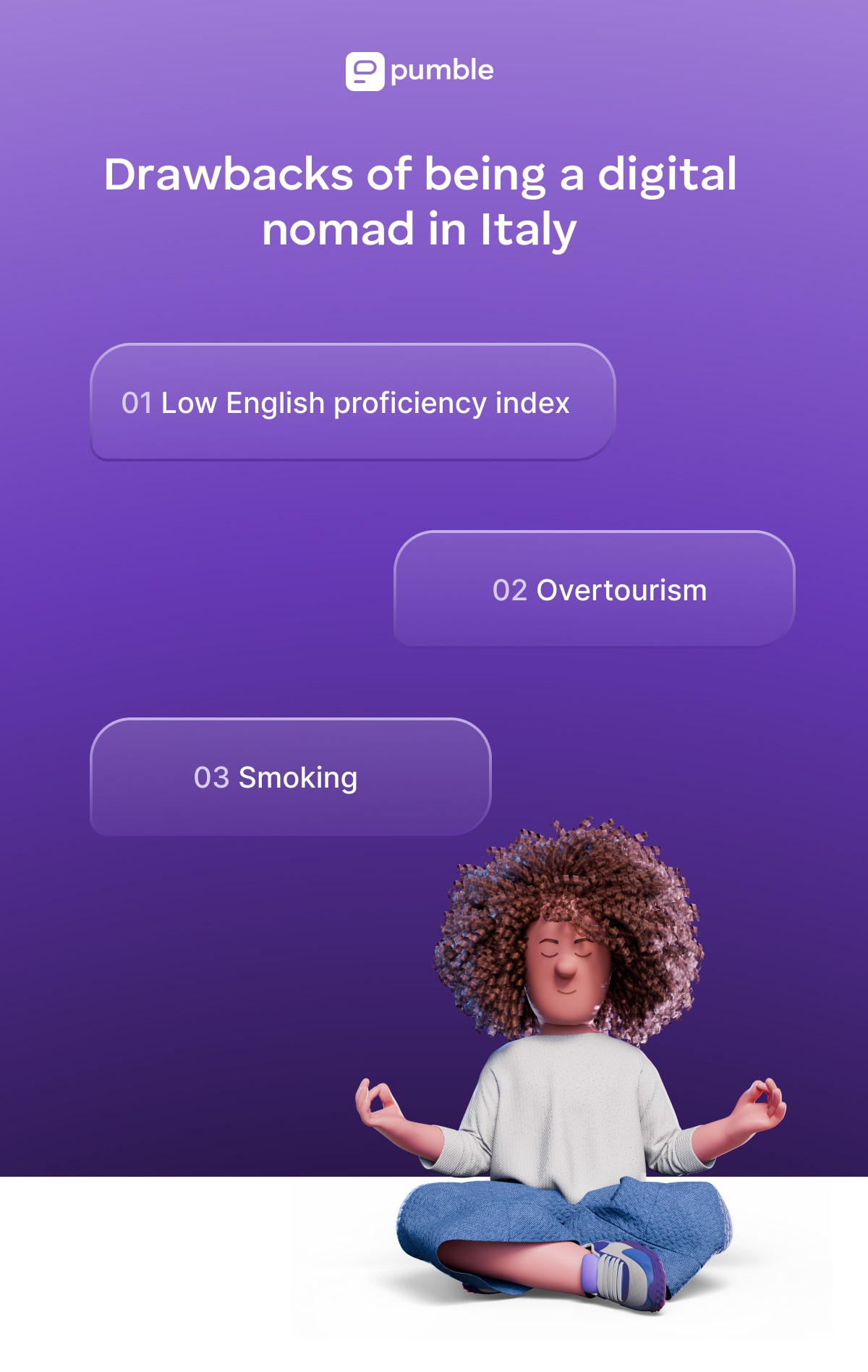
Here are some of the most significant drawbacks of living in Italy as a digital nomad.
Drawback #1: Low English proficiency index
If you’re traveling to Italy without the knowledge of some basic phrases in Italian, prepare for a fair share of gesturing and hand waving — with just a touch of frustration.
Even though Italians are more than likely to try their best to help you with anything you might need, their English knowledge is not at the level you might be used to in other European countries.
Italy scored relatively low in the 2024 English proficiency rankings, earning 46th place globally, which puts it in the moderate proficiency category.
However, if you’re patient and polite, you will probably be able to get almost anything done with just a little bit more effort.
Drawback #2: Overtourism
Tourism makes up around 13% of Italy’s GDP, which means huge tourist crowds during the spring and summer months.
Although profitable, this has been a massive problem for Italy and its citizens. So much so that, in recent years, Italy has started implementing small but important measures to combat the effects of overtourism. They include the ban of selfies or flip-flops in certain places and prohibition of cruise ship docking in specific ports.
Large tourist groups and tourist traps in popular Italian areas can cause discomfort and frustration for both native Italians and digital nomads who plan to spend a substantial amount of time in the country.
Unfortunately, there’s not much you can do about this problem since peak season in Italy is considered to last from early May up to late September.
However, overtourism is probably more of a pet peeve than a major issue. After spending some time in Italy you’ll almost definitely find ways to get around the crowds, noise, or other various annoyances.
And even if you don’t, you’ll probably find ways to appreciate the experience, if nothing else. After all, digital nomads most often visit a country to immerse themselves in its culture to the fullest.
Drawback #3: Smoking
While smoking in closed public places is prohibited by law in Italy, there are a great number of designated smoking areas and rooms in almost any establishment. What’s more, smoking outdoors is a very common occurrence.
If you come from a country where smoking is not allowed in most places — get ready and arm yourself with patience you’ll need to deal with second-hand smoke.
5 Best destinations for digital nomads in Italy
Now that we’ve uncovered all the methods of coming to live in Italy as a digital nomad, and some of the most important pros and cons of doing so, it’s time to pick the best destination for your home base while you’re there.
As we mentioned many times before, Italy is one of the most gorgeous countries in the world, so it’s impossible to pick only a couple of destinations — but we’ll give it a try. Moreover, we’re sure you’ll find some free time to explore some other parts of the country that we couldn’t fit into this guide.
So, without further ado, here are the top 5 destinations for digital nomads in Italy.
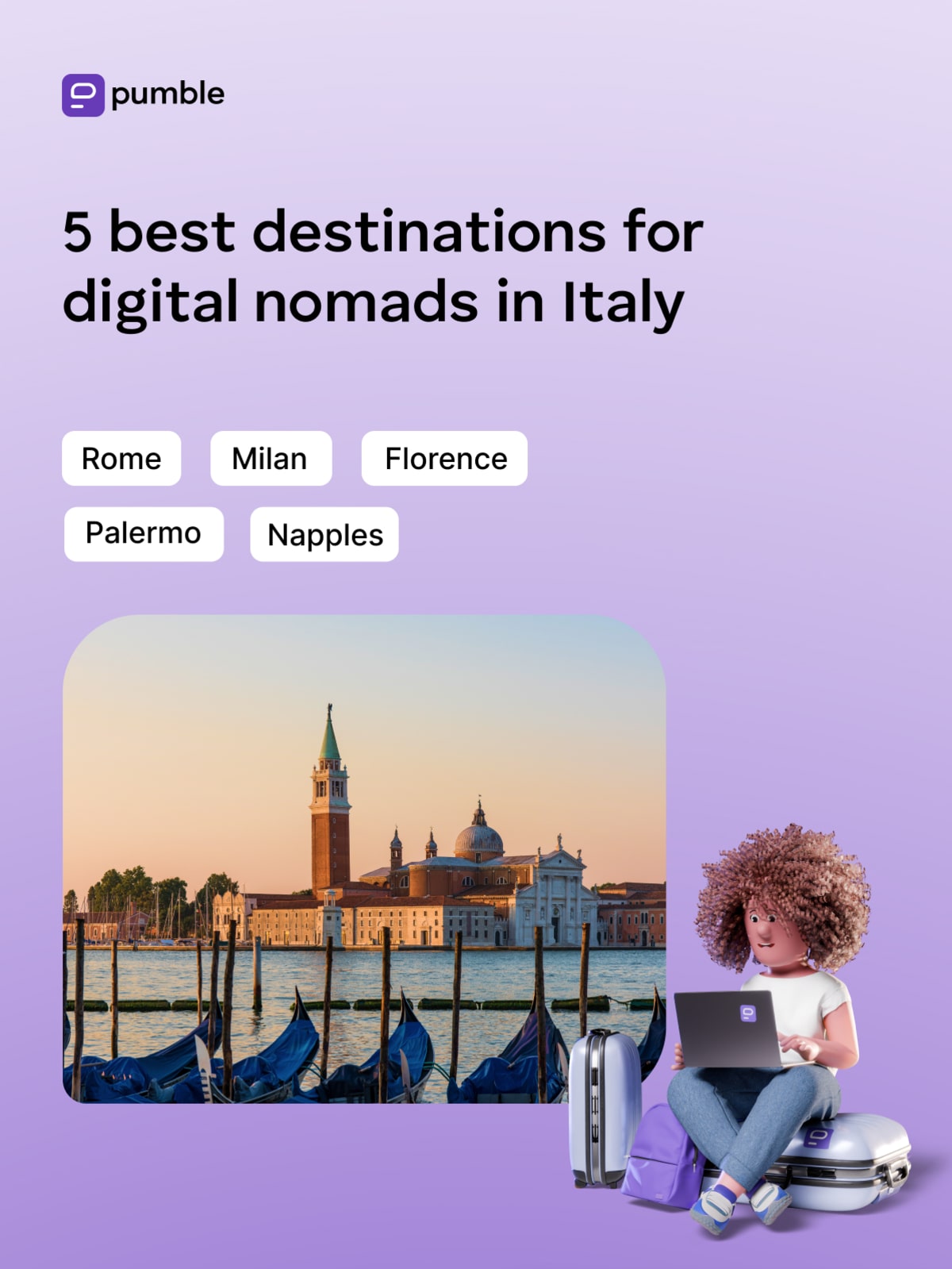
Rome — Best for those who like history and culture
Population: 4,331,970
City area: 496.14m² (1,285 km²)
Time zone: GMT+1/GMT+2 (CET)
Average internet speed: 102.16 Mbps (median download speed), 32.84 Mbps (median upload speed)
Average cost of living: €846.8 (~$913.42) per month for one person (without rent); €2,943.9 (~$3,175.06) per month for a family of 4 (without rent)
Average cost of rent: €1,000–€1,600 (~$1,078.52–$1,725.63) for a 1-bedroom apartment per month
Biggest advantage: Rich in culture and history
Biggest drawback: Crowded with tourists
Rome really has it all for the explorer type of digital nomads — from the comfortable Mediterranean climate, plenty of historical and cultural sites, and world-renowned cuisine to a wide range of accommodation and coworking options.
Here are our top picks for things you can do in Rome:
- Visit the iconic Colosseum and Pantheon.
- Take a walk through beautiful Villa Doria Pamphili or Villa Borghese parks.
- Throw a coin in the Trevi Fountain (or take an underground tour of Trevi if you’re adventurous).
- Take a Trastevere Rome food tour.
- Rent a Vespa and drive around the city.
Rome is generally considered welcoming to foreigners and it’s quite safe. However, as the country’s capital, Rome isn’t the most affordable option for nomads on a budget, so expect higher rent prices, especially closer to the city center.
And, as one of the most popular tourist destinations in the world, Rome gets crowded with tourists during the spring and summer months, so it’s virtually impossible to do any work outside your accommodation or a designated coworking space.
Still, the city makes up for its drawbacks with its unbelievable charm and plenty of coworking spaces and networking opportunities in general.
Where to work in Rome
There are hundreds of coworking spaces in Rome. The highest-rated one, according to Google, is the Wire Coworking, with a 4.9-star rating out of 116 reviews.
Milan — Best for those who like the fast-paced city life
Population: 3,160,630
City area: 70.19 mi² (181.8 km²)
Time zone: GMT+1/GMT+2 (CET)
Average internet speed: 150.15 Mbps (median download speed), 95.32 (median upload speed)
Average cost of living: €993.1 (~$1,071.08) per month for one person (without rent); €3,516.7 (~$3,792.57) per month for a family of 4 (without rent)
Average cost of rent: €1,000–€2,000 (~$1,078.52–$2,156.89) per month for a 1-bedroom apartment in the city center
Biggest advantage: Amazing networking opportunities
Biggest drawback: Expensive
As one of the world’s most important fashion capitals and the main technology, finance, and commerce center in Italy, Milan is naturally the number one pick for digital nomads looking for a cool big-city vibe.
In addition to having great infrastructure, amazing networking opportunities, and vibrant culture, Milan also has a rich cultural heritage.
It is home to some of the world’s most important cultural and historical sites such as:
- The Duomo of Milan,
- Galleria Vittorio Emanuele II,
- La Scala Opera House, and
- The Church and Dominican Convent of Santa Maria delle Grazie with “The Last Supper” by Leonardo da Vinci (a UNESCO World Heritage Site).
If you’re into exploring the local bar and club scene, you’ll find plenty of fun options in Milan, as the city is widely known for its exciting nightlife.
It should be noted that the city is quite expensive. However, you can always save on rent by opting for a location outside of the city center, for example.
Where to work in Milan
One of the biggest advantages for digital nomads staying in Milan is the sheer amount of great coworking spaces. There are hundreds of well-equipped places to choose from if you don’t like to work from busy cafes, or you want a change of scenery from your regular setup in your accommodation.
The highest-rated coworking space in Milan according to Google is the COWO® HQ – Coworking Milano Lambrate. It has a rating of 4.8 stars from 106 reviews.
Stay connected with your team — Try Pumble
Florence — Best for creatives who like a relaxed vibe
Population: 712,176
City area: 39.53 mi² (102.4 km²)
Time zone: GMT+1/GMT+2 (CET)
Average internet speed: 79.2 Mbps (median download speed), 20.17 Mbps (median upload speed)
Average cost of living: €928.5 (~$1,001.38) per month for one person (without rent); €3,275.2 (~$3,532.26) per month for a family of 4 (without rent)
Average cost of rent: €800–€1400 (~$862.79–$1,510.40) per month for a 1-bedroom apartment in the city center
Biggest advantage: Magnificent scenery
Biggest drawback: Intense heat in the summer
Florence is ideal for digital nomads looking to experience authentic Italian culture and see some of the world’s most magnificent cultural, architectural, and artistic masterpieces.
The entire Historic center of Florence is a UNESCO World Heritage Site, so when you’re not working, you’ll probably find yourself walking around the picturesque streets of Florence admiring the Renaissance art and architectural gems located in this city.
You’ll also be tempted to explore other parts of the scenic Tuscany region, so make sure to plan a couple of weekend tours to some of its world-renowned vineyards.
Although the cost of living in Florence is by no means cheap, it’s still more affordable than in Rome or Milan.
You can find decent accommodation outside of the city center in areas such as the up-and-coming bohemian nomadic neighborhood — Santo Spirito, or Santa Croce — which is perfect if you enjoy the bustling nightlife.
Where to work in Florence
Although the city looks like one big, beautiful museum, Florence also has a great infrastructure and plenty of options for digital nomads to work, organize community gatherings, and network.
There is a wide variety of coworking spaces in Florence with average monthly prices of around €149 (~$160.75), which is relatively cheap compared to prices in Rome and Milan. Nana Bianca is a coworking place that has the highest rating (4.8 stars based on 193 reviews), according to Google.
Palermo — Best for those who like beautiful nature and island vibe
Population: 850,233
City area: 61.35 mi² (158.9 km²)
Time zone: GMT+1/GMT+2 (CET)
Average internet speed: 151.5 Mbps (median download speed), 92.91 Mbps (median upload speed)
Average cost of living: €783 (~$844.75) per month for one person (without rent); €2,703.8 (~$2,917.02) per month for a family of 4 (without rent)
Average cost of rent: €450–€750 (~$485.45–$809.09) per month for a 1-bedroom apartment in the city center
Biggest advantage: Best of both worlds — calm and lively at the same time
Biggest drawback: Public transportation not as reliable as in other Italian cities
Palermo is perfect for digital nomads who like a more relaxed, island vibe with wonderful weather, beautiful scenery, and a growing digital nomad community.
The city offers the best of both worlds in a way. On the one hand, you have the traditional Sicilian welcoming culture and a slower pace of life, while, on the other hand, you’re still getting all the perks of city life and optimum infrastructure to make your work and day-to-day life easier.
Palermo (and Sicily in general) is also considerably cheaper than most other cities in Italy (and the EU). With an average cost of living of around €783 (~$844.69) without rent per person, Palermo is a perfect option for digital nomads on a budget.
Although you’ll notice trash piles in the streets from time to time and encounter many smokers and smoking areas, Palermo has good air quality and offers a solid base for nomads looking to maintain a healthy lifestyle and a good work-life balance.
Where to work in Palermo
If working on a beautiful beach isn’t your forte, you can opt for one of the options from the growing list of coworking spaces in Palermo. With a 5-star rating out of 49 reviews, the Magnisi coworking space has the highest rating according to Google.
Working remotely? Keep the collaboration going with Pumble
Naples — Best for those who like authentic Italian culture
Population: 2,180,000
City area: 45.28 mi² (117.3 km²)
Time zone: GMT+1/GMT+2 (CET)
Average internet speed: 106.08 Mbps (median download speed), 64.68 Mbps (median upload speed)
Average cost of living: €820.7 (~$885.36) per month for one person (without rent); €2,859.8 (~$3,084.99) per month for a family of 4 (without rent)
Average cost of rent: €650–€1,500 (~$701.18–$1,618.11) per month for a 1-bedroom apartment in the city center
Biggest advantage: The city’s authentic vibe
Biggest drawback: Safety concerns in certain city areas at night
If you’d like to experience authentic Italian culture with all the perks and infrastructure of a big city, Naples might be the place for you.
Naples is the 3rd biggest city in Italy, with the largest historic city center in Europe listed as a UNESCO World Heritage Site. Moreover, it is known for other historical and natural landmarks, including the nearby Roman ruins of Pompeii and the magnificent Mount Vesuvius.
Apart from exploring the cultural heritage of Naples, you’ll also have the opportunity to try the world’s best pizza right from the source, as the first pizza ever was, allegedly, made in Naples.
Naples is relatively cheap compared to other bigger cities, so you’ll find decent places for rent for around €650 (~$701.18) per month.
For a more authentic Neapolitan experience with lower prices, you can pick the Quartieri Spagnoli (the Old Spanish Quarter) as your base in Naples. If you prefer a more vibrant atmosphere with lots of shopping and restaurant options, you can look for places around the historic center of Piazza Dante.
Where to work in Naples
If you like to keep your living and working areas separate, you’ll be happy to learn that Naples has a great offer of coworking spaces to accommodate all types of remote workers. Dialogue Place tops the list with a rating of 4.9 stars from 95 Google reviews.
🎓 Pumble Pro Tip
If you can’t seem to find the perfect place for your workation in Italy as a digital nomad, you can also check out which other countries offer digital nomad visas:
And, if you find one that you fancy as your next destination, check out whether we have a full guide on how to apply for a digital nomad visa in that country:
Tips for digital nomads in Italy
Coming to Italy as a tourist and living and working there as a digital nomad are two completely different concepts.
While you’re pretty much all set up on a tourist arrangement, as a digital nomad you’re left to fend for yourself. This often involves learning to navigate the complex Italian bureaucracy, as well as language and cultural barriers.
To help you overcome some common challenges, we’ve compiled additional tips on how to have the smoothest possible experience as a digital nomad in Italy.
Tip #1: Get legal advice
As you’ll notice from the moment you start planning your Italian nomadic experience, Italy has a highly complex bureaucracy. On top of that, official resources are limited and poorly updated, so in most cases, you’re left to rely on your own investigative skills.
To avoid the strenuous process of figuring out all the different requirements and navigating the complex tax system in Italy all by yourself, you might be best off getting in touch with legal teams specializing in Italian immigration law and/or the Italian tax system.
Tip #2: Check the internet speed before booking accommodation
Although generally reliable and fast on average, the Internet in Italy can be a hit or miss, depending on where you are located. In most cases, download speeds are fine pretty much anywhere in the country.
However, if your work requires plenty of video conferencing, be sure to check the upload speeds before renting a space.
Coworking spaces will have great internet speeds, and major cities like Rome and Milan probably won’t ever disappoint.
However, if you happen to be in less urban areas, you might experience some unpleasant surprises in this regard, so it’s best to err on the side of caution and make sure you have all the resources for uninterrupted work ready.
Tip #3: Get in touch with locals
Sure, tourist guides and popular resources can get you accurate information on official data and offers. However, if you want to experience a more authentic (and more affordable) Italian lifestyle, your best bet is to get acquainted with the local community.
This shouldn’t be difficult, especially in the more southern parts of the country where people are known to be super friendly and welcoming to foreigners — so use this to your advantage.
Building friendly relationships with locals can help you get more accurate info on all the best places, restaurants, off-the-beaten-path locations, and affordable accommodation options.
And, while you’re at it, you might also learn some Italian — a skill much needed since English is not as widely spoken in Italy as you may think.
Tip #4: Make a plan
More often than not, you’ll find yourself experiencing extreme FOMO in Italy, simply because there is so much to see and do in this beautiful country.
To avoid losing sleep or hours of work trying to be everywhere at once, try to come up with a realistic plan including destinations, work hours, budget, free time, and trip itineraries.
Tip #5: When in Rome, use the official Roman taxis
Another invaluable tip from our contributor, Saema Nasir, pinpoints the super convenient and oftentimes the most affordable alternative to public transportation when navigating the busy streets of Rome — the official city taxis.

“I recommend always having euros on hand for using the official Roman taxis. If you aren’t using public transport, I highly recommend using official taxis, which, at times, are cheaper than an Uber ride anyway! Note that you can only catch an official taxi from an official taxi stop where they are usually parked — no official taxi will stop by being hailed.”
Further reading for digital nomads in Italy
Here are some additional sources we recommend you check out before or after you arrive in Italy:
- The Italian Association of Digital Nomads — initiatives and programs aimed at making Italy more digital nomad-friendly.
- Tripadvisor’s Italy tour guide — plenty of information on what to do and see in Italy.
- Digital Nomads Italy — the official website for digital nomads in Italy offering information on communities, best coworking spaces, accommodation suggestions, and legal and tax advice.
- NomadList and The Nomadic Network — communities of digital nomads living and traveling around the world.
Stay connected to your team with Pumble
While you’re exploring all the beauty Italy has to offer on your digital nomad journey, your main challenge might be staying up to date on work all the time.
Luckily, you don’t have to compromise on the quality of your team communication and connection — thanks to Pumble.
Pumble is a team communication app that keeps your team connected and synchronized through functionalities such as:
- Direct messages — for one-on-one chats or group chats with your team,
- Channels — for team topic-oriented discussions in an organized space,
- Video conferencing — for much-needed face-to-face time with your team members,
- File sharing — for easy collaboration and unlimited storage, and
- Meeting recording — for asynchronous communication when you and your team are working across time zones.
Experience more productive team communication and collaboration — make a free Pumble account today!
Italy digital nomad visa guide disclaimer
We hope this Italy digital nomad visa guide has been helpful and that you enjoyed reading it. Throughout the guide, we have given you various links that might lead you to new interesting data or simply to articles that will expand your knowledge on various topics.
Please bear in mind that our article has been updated in Q2 of 2025, so any changes made in the Italy digital nomad visa procedures or laws after that time have not been included.
Before you start the application process, we advise you to consult with certified representatives, lawyers, and institutions that can provide you with all the information needed.
Pumble is not responsible for any negative responses, losses, or risks incurred, should this guide be used without further guidance from legal and other official advisors.
How we reviewed this post: Our writers & editors monitor the posts and update them when new information becomes available, to keep them fresh and relevant.




